Beef prices are projected to continue increasing as U.S. beef production declines with no signs of a cattle herd rebuild. Additionally, cheap beef may soon become further out of reach…
2023 Farm Sector Income Forecast, February
The USDA’s Economic Research Service (ERS) indicated on Tuesday that, “Farm sector income is forecast to fall in 2023 following two years of strong growth. Net farm income, a broad measure of profits, is forecast to decrease by $25.9 billion (15.9 percent) from 2022 to $136.9 billion in calendar year 2023.”

“Net cash farm income is forecast to decrease by $39.4 billion (20.7 percent) from 2022 to $150.6 billion in 2023, after an annual increase of $32.7 billion (28.0 percent) in 2021 and a forecast increase of $40.4 billion (27.0 percent) in 2022. In inflation-adjusted dollars, net farm income is forecast to decrease by $30.5 billion (18.2 percent) in 2023 and net cash farm income is forecast to decrease by $44.7 billion (22.9 percent) compared with the previous year.
If realized, both income measures would remain above their 2020 level and 2002-2021 average (in inflation-adjusted dollars).
ERS pointed out that, “Overall, farm cash receipts are forecast to decrease by $23.6 billion (4.3 percent) from 2022 to $519.9 billion in 2023 in nominal dollars,” and, “Direct Government farm payments are forecast at $10.2 billion in 2023, a $5.4 billion (34.4 percent) decrease from 2022 levels.”
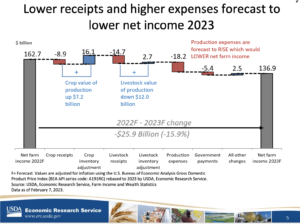
Tuesday’s update stated that, “Corn receipts are forecast to fall by $4.1 billion (4.5 percent), as higher quantities sold are not expected to offset lower expected prices…[and]…Soybean receipts are expected to decline $5.2 billion (8.1 percent), mainly due to lower forecasted prices.”
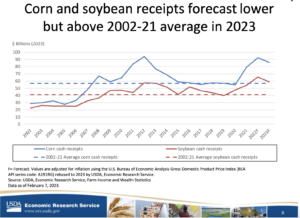
ERS stated that, “After reaching a record high of $45.6 billion in calendar year 2020, direct Government farm program payments decreased to $25.9 billion in 2021. They are forecast to decrease further to $15.6 billion and $10.2 billion in 2022 and 2023, respectively.”
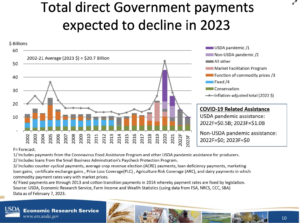
“Conservation payments from the financial assistance programs of USDA’s Farm Service Agency (FSA) and Natural Resources Conservation Service (NRCS) are expected to be $4.0 billion in 2023, up $462.1 million (or 13.0 percent) from the 2022 forecast amount.”
ERS also explained that, “Farm bill commodity payments under the Agriculture Risk Coverage (ARC) and Price Loss Coverage (PLC) programs are forecast to decline by $303.4 million, or 81.4 percent, in 2023 to $69.1 million.”
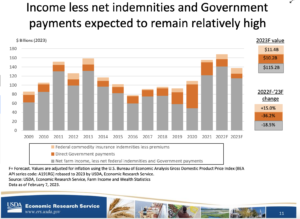
With respect to production expenses, ERS noted that, “Farm sector production expenses—including expenses associated with operator dwellings—are forecast to increase by $18.2 billion (4.1 percent) from 2022 to reach $459.5 billion in calendar year 2023.”
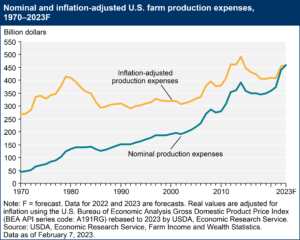
More narrowly, ERS pointed out that, “Interest expenses (including operator dwellings) are forecast to rise by $6.2 billion (22.4 percent) to $33.8 billion in 2023 following a projected increase of $8.2 billion (42.1 percent) in 2022. This reflects expectations that debt levels for the sector and interest rates will continue to grow in 2023, although at a slower rate than in 2022.”
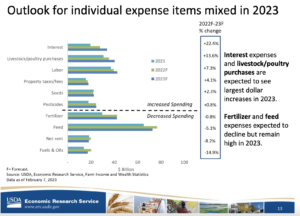
“Fuel and oil expenses are projected to fall by $3.0 billion (14.9 percent) to $17.1 billion in 2023.”





